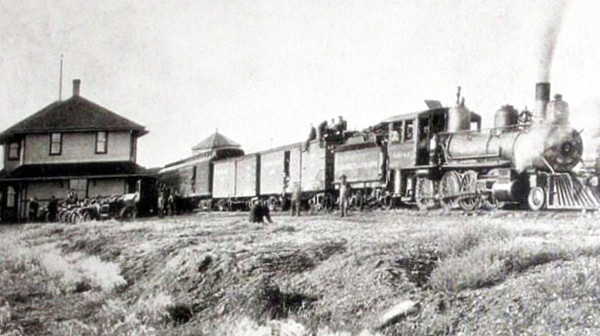
The Laramie, Hahn's Peak and Pacific terminal building, Laramie, approx. 1911.
In 1901 planning and construction of the Laramie, Hahn's Peak,and Pacific Railway began. The company's yards were at the
western end of Fremont in Laramie. Little trace of the yards are left.If one looks
carefully the roadbed for the "wye" may be seen. A wye was a set of tracks looking like an upside down letter Y which was used for turning the
train around. The Terminal Building depicted above is now gone.
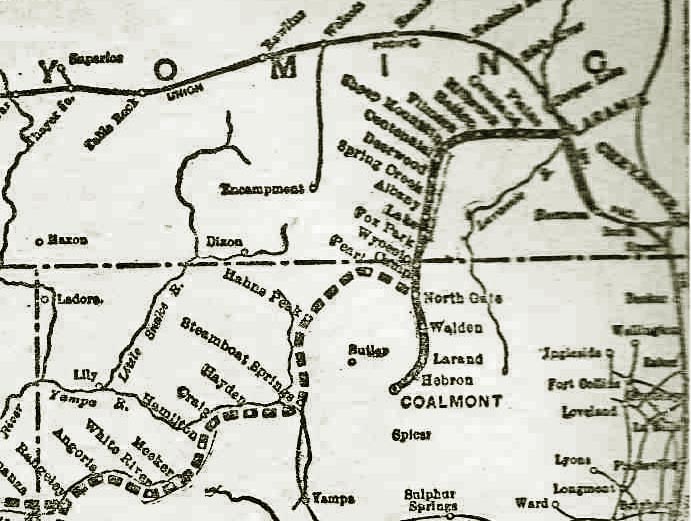
Map of portion of planned routes for
the Laramie, Hahn's Peak and Pacific.
The announced route for the railroad was from Laramie into Colorado, thence to Steamboat Spings and over to Grand Junction. It would then extend into
Utah and ultimately to the Pacific. Plans called for it to have 500 miles of track in Southern Wyoming and in
Colorado. Originally, it was planned for the railroad after it reached Centennial would go to
Saratoga and then Encampment. he railroad would carry coal from mines in Colorado and gold and copper from Centennial and Jelm.
But by the time the railroad reached Centennial, the Saratoga and Encampment had already reached
Saratoga. Thus, the route was changed to Foxpark, Walden, and Coalmont. Isaac Van Horn, the man behind the L.H.P. & P. had made his initial money as a grocer in Nebraska before moving to Boston. Van Horn in his capacity
as an investment banker recommended the sale of the railroad's bonds as a "most conservative 6% investment."
Securities and Exchange Commission Reports, Vol. 116, p. 352 (1921) reflect that Van Horn recieved from the railroad $2,750,000 in stock
"without detailed information to show that any property was received" from Van Horn. Van Horn promoted the railwoad advertizing that it would be to Southern Wyoming what the Denver and Rio Grande was to
Colorado.
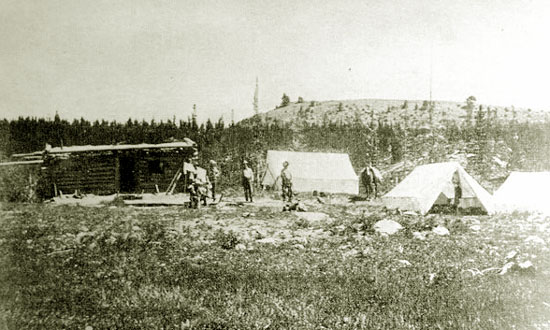
Surveying Party for the Lamamie,
Hahn's Peak and Pacific Railroad, 1901.
With the route layed out, the railroad proceeded to obtain the necessary right of way. As noted by
Chief Justice Roberts in Marvin M. Brandt Revocable Trust v. United States (2014) by 1908 pursuant to an 1875 Act of
Congress the government granted the railroad
a right of way across government lands. In Wyoming, the right of way was 66 miles long and 200 feet wide. It meandered south from
Laramie through the Medicine Bow-Routt National Forest, to the Wyoming-Colorado border. As discussed below, for nearly
100 years the Laramie, Hahn's Peak and Pacific, under various names and operators,
jingled, rumbled, and roared,
As she dashed thro' the woodland, and sped through the snow.
Hear the mighty rushing engine, as her merry bell rings out,
As she speeds along in safety, on the "Laramie Plains Line." [Apologies to J. A. Roff, reputed author of the "Wabash Cannonball."
The diffent names under which the road operated were:
1901-1914, Laramie Hahn's Peak & Pacific
1914-1924, Colorado, Wyoming & Eastern
1924-1951, Laramie, North Park & Western
1951-1986, Coalmont Branch, Union Pacific
1986-1996, Wyoming & Colorado Railroad
The railroad was a minor almost forgotten, generally unread footnote, to
the grand scheme of the history of Wyoming and Colorado. As discussed on a later page,
the railroad remained an obscure footnote until 2014. In "Abandoned Railroad Rights-of-Way" Jeff Bleich and Josh Patashnik wrote
that Justice Robert's decision "is not one of those obscure Supreme Court
cases soon to be relegated to the small-print explanatory notes at the end of a legal
textbook chapter." Bar Association of San Francisco, Summer 2014, p. 54. The significance of the
decision will be discussed on a later page.
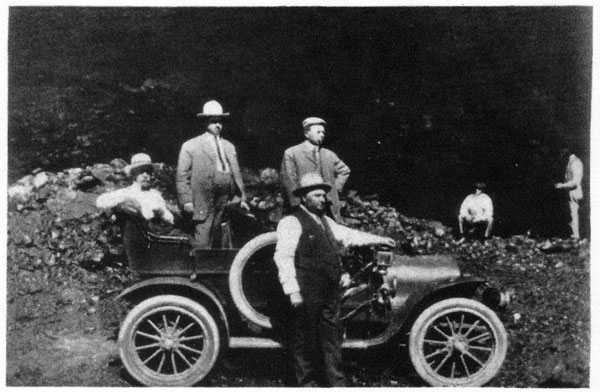
Inspection of Riach coal vein near Coalmont, Colorado, C. 1910. Portly individual in front believed
to be Fred A. Miller, President of the Railroad. Seated in back seat is Otto Gramm, Vice-President of the
Railroad. In 1914 Gramm established the Fox Park Timber Co. which produced railroad ties. He also had a
Tie Camp near a large sawmill at Gramm, Wyoming, south of Fox Park. For discussion and photos of
Fox Park see next page.
In Colorado beginning about 1905, a Hebron, Colorado rancher James C. Riach began the employment
of dummy entrymen for the
aquisition of coal lands in the North Park area of Jackson County, Colorado near Coalmont.
Miller with several others also began the aquisition of coal lands.
The use of the dummy entrymen was, of course, in violation of Federal law and was fraudulent.
See Northrn Colorado Coal Co. v. United States, 234 F. 34 (8th Cir. 1916). The
coal lands were then conveyed to the Van Horn and Miller's Northern Colorado Coal Co. Coal
without railroad transportation is of value for
only local sale.
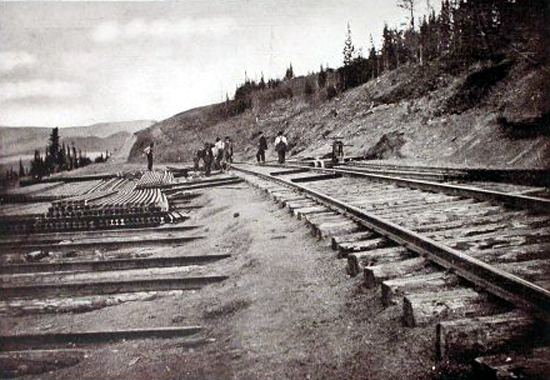
Laying rail for the
L. H. P. & P.
In Laramie, Another Van Horn corporation, Acme Consolidated Gold & Mining Company formed to develop Centennial, acquired a number of city lots and an office building. At
Centennial, the company aquired in addition to the townsite, 100,000,000 feet of standing timber, a sawmill, planing-mill and lumber
yard, and the Centennial Post newspaper. The "Rocky Mountain Country Club" was to be
located on a 320 acre site. The Club was to feature, among other amenities, polo grounds.
Col. Van Horn (he was an aide de camp to the Governor Henry B. Quinby of
New Hampshire with the title of "Colonel."), belonged to two country clubs in New England.
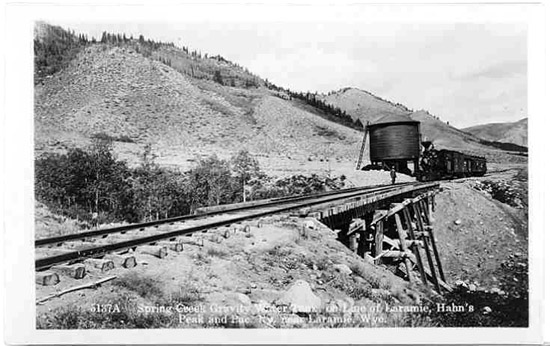
Gravity Water Tank,
L. H. P. & P. Railroad, Spring Creek.
Raising money to construct the railroad was slow. After three years, the railroad had laid only seven miles of track. In
December, 1906, Col. Van Horn announced that soon there would be "startling news." By then, the
stock in the railroad was selling for forty cents a share.
In Febrary 1907, Col. Van Horn predicted that the entire line would be completed within 18 months. Actually,
it took four more years to reach the coal mine at Coalmont, Colorado, It never reached its proposed ultimate destination. However,
in 1907, the railroad finally reached Centennial. The slowness of construction perhaps gives a different meaning to the local joke that
L.H.P.& P. as standing for "Long Hard Pull and Perhaps."
In Centennial, as described by Professor Larson, the railroad "paused." After pausing, the railroad reset its course for
Walden and Coalmont. By 1910 it finally reached Fox Park and the state line.

Grading for the Lamamie,
Hahn's Peak and Pacific Railroad west of Fox Park, Wyo. Photo by J. H. Van Horn (attributed).
By 1910, however, mail addressed to the gold
mining company in Laramie was being returned as undeliveable. By late 1911, the Railroad had
reached the Coal Company's mine at Coalmont. The rolling stock for the railroad was minimal. It had
three locomotives,18 cars and one rotary plow.
Unfortunately, by 1911, the bloom was off
the mining boom in the Medicine Bows and Centennial. Other difficulties lay on the horizon.
An action was brought by the Federal Government against the coal company to set aside the patents issued
for the coal lands. The patents were set aside by the United States District Court. The ruling was
sustained on appeal. See Northern Colorado Coal Co. v. Unted States, 234 F. 34 (8th Cir. 1916).
The Companies went into receivership. In 1913, Col. Van Horn filed for personal bankruptcy. The bankruptcy schedules
showed that he had liabilities exceeding $778,000 and assets of $100.00.
In 1914, the railroad was sold in a foreclosure sale and later sold to the Colorado, Wyoming & Eastern Railway Company. Subsequently it was sold
to the Union Pacific. The line is now abandoned and the rolling stock sold to a railroad
in Arizona.
With the failure of the railroad and mining companies, Col. Van Horn moved to Florida.
By 1922, he had established an oil company to drill for oil in the Green Swamp of Polk County, Florida.
On the edge of the swamp and on the shores of Lake Agnes and Mud Lake he established a new town named
"Polk City." The town, at an elevation of 173 feet, was promoted as being in the "Scenic Highlands" of
Florida. After seven years of searching for oil without success, Col. Van Horn pulled his drilling rigs out of the swamp.
In the Florida Boom of the 1920's many great cities arose. Polk City was not one of them. By 1960, its
population had descended from a peak of 600 to 203. With the growth in the Central Florida corridor, the town has begun to come back and
now has a population of about 2,000.
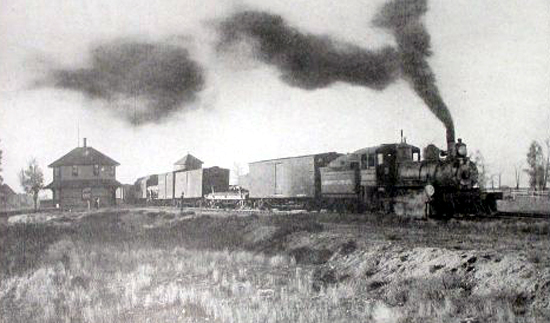
Laramie
Depot.
J. H. Van Horn, the younger brother of Isaac Van Horn, was the "official photographer" for the L.H.P. & P.
Hope that there is gold in them thar hills springs eternal. In December of 2000, the
Wyoming State Geological Survey announced that a sample rock had been found at
Centennial Ridge that was
"highly anomolous in gold," leading to the possibility that the gold vein may
yet be found.
Background music this page: Rattlin Cannonball as sung by Montana Slim.
Next Page Laramie, Hahn's Peak & Pacific Railway continued, Foxpark.
|